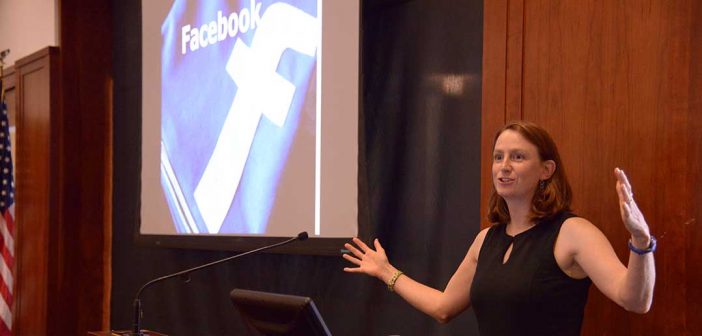Teenagers haven’t left Facebook, but they’re more involved than ever in a virtual archipelago of social media spaces that educators can take advantage of—if they tread lightly, a researcher told educators on July 13.
“We need to unpack the myth … that young people are technological wizards. There certainly are some who are, but not every kid is like that. I think before we use these
spaces in the classroom, we have to think about why we’re doing it, and what we’re walking into,” said Amanda Lenhart, speaking at Fordham’s Lincoln Center campus.Lenhart, a researcher with the Data & Society Research Institute, delivered a keynote, “The Shifting Landscape of American Teens’ Social & Digital Media Use,” at the fourth annual Developing Digital Literacies Conference, hosted by the Graduate School of Education.
“If [educators] ask young people to use a social space, we want to give them options so they don’t necessarily have to have their personal space invaded by the academic, and vice versa.”
She tackled topics such as the rise of the smart phone, and teens’ need for access, texting, relationships, and privacy.
When it comes to relationships, Lenhart said, it will surprise few to learn that social media is where teens make, maintain, and end friendships. What was heartening, she said, was talking to the 20 percent who said they’d met someone of interest online and then arranged to meet in person.
“It may have been pretty far removed, like their best friend’s cousin’s ex-boyfriend, but usually somebody … else in their network verified that that person [first],” she said.
In addition to meeting a new person in a public setting and accompanied by friends, many teens vet the person beforehand through technology like Facetime, she said.
“For me, that was comforting to learn. They’ve had this stuff drilled into them for many years.”
Facebook is still a must-have for teens, if only because it’s where everyone has an account. But Lenhart noted that one teen dismissed it as “drama central” in part because when a teenager is friends with parents, coaches, family friends, and classmates, it’s difficult for them to decide which side of themselves to display. Other platforms offer teens a place to create smaller networks that are easier to manage and find privacy, but might facilitate social pressures, with myriad unspoken customs and norms.
For example, on Instagram, teens might be tempted to “like” a picture that they have shared so as to drive up the number of likes on the post. Savvy teens know to wait until 11 others have liked it first, because after 11, Instagram stops showing the names of those who have liked it, and only displays the number of likes. A savvy friend might still click through,and find the like, and call out the teen for “liking” themselves. But if they do, they can be accused of stalking—another teen taboo..
“Think about that. That’s exhausting! So it’s not surprising that teens continually move from spaces that are exhausting and complicated to spaces that are less so,” said Lenhart.
The takeaway for teachers is that social media is a deeply complicated and personal endeavor, and should be thought of as a private space like any other. Lenhart said the Discover function on Snapchat is a good example of a space that educators can explore..
“The private spaces often have more possibility because they aren’t about broadcasting to a network.”



